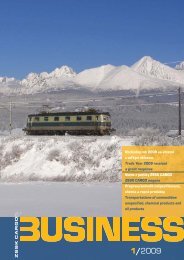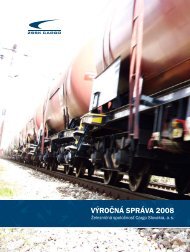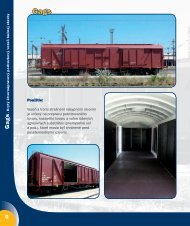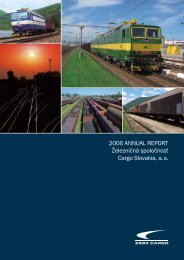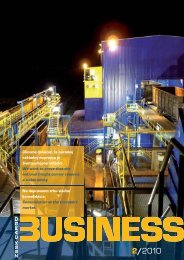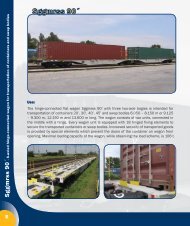Nálepky na označovanie nebezpečenstva, nálepky pre posun, doplňujúcenálepkyNálepky na označovanie nebezpečenstva sa umiestňujú na odosielanékusy, prepravné aj dopravné prostriedky. Svojím vyobrazením poukazujúna nebezpečné vlastnosti prepravovanej látky. Rozmery, farebnévyobrazenia, symboly, text a čísla sú presné stanovené Poriadkom RID(pozri časť 5 RID).Nálepky musia byť odolné voči vplyvu počasia, aby nedošlo k poškodeniuich efektu. Na polepovanie odosielaných kusov (kap. 5.2 RID) saspravidla používajú nálepky s rozmermi minimálne 100 x 100 mm.Na polepovanie prepravných alebo dopravných prostriedkov (kap.5.3 RID) sa používajú veľké nálepky (Placards) s rozmermi minimálne250x250 mm. Poriadok RID pripúšťa výnimky zo stanovených rozmerovv osobitných prípadoch vymenovaných v RID.Označovanie dopravných/prepravných prostriedkov je rôzne; kým napr.cisternový vozeň stačí označiť nálepkou na označenie nebezpečenstvana každej pozdĺžnej strane, kontajner musí byť označený na všetkýchštyroch stranách. Pred odoslaním zásielky s nebezpečným tovarom jepreto dôležité, aby si zákazník overil v kapitole 5.3 RID, či ním odosielanýdopravný/prepravný prostriedok vyhovuje podmienkam RID a čipoužité nálepky pre konkrétny nebezpečný tovar sú nálepky predpísanév tabuľke 3.2-A pre konkrétne UN číslo.V praxi sa bežne stretávame s nálepkami, ktoré okrem vyobrazenéhovzoru podľa RID obsahujú doplňujúce nápisy. Aj toto RID pripúšťa, aleuvedené nepovinné údaje musia byť v súlade s 5.2.2.2.1.5 RID. Nikdevšak v RID nenájdeme farebné odtiene modrej, červenej, žltej a zelenejfarby, ktoré majú byť na nálepke použité. Výnimku tvorí oranžová farba,ktorej súradnice farebnosti sú v RID presne definované pri popiseoranžového označenia. Neostáva teda nič iné, len sa približne trafiť dovyobrazenej farby podľa vzorov v RID. Platí ale jedna zásada, že symboly,číslice a lemy musia byť farebne zhodné (buď čierne alebo bielev prípadoch, kedy sa to v RID pripúšťa ).Najčastejším riešením použitia nálepiek bol v minulosti samolepiacipapier, ale prax ukázala, že toto riešenie bolo nedostatočné. Nálepkavyobrazená na samolepiacom papieri, nalepená na vozni, častonevydržala poveternostné a klimatické podmienky a takto označenývozeň nedošiel do stanice určenia s predpísaným označením. Takýtoprípad je považovaný za porušenie povinností odosielateľa, pretoženezabezpečil označenie vozňa na celú prepravnú cestu. Navyše vznikápovinnosť pôvodnému prijímateľovi opäť označiť napr. cisternovývozeň, ak ho prázdny nevyčistený odosiela po vyložení späť pôvodnémuodosielateľovi.Preto zákazníkom doporučujeme po skúsenostiach získaných aj odzahraničných kolegov používať samolepiace fólie, ktorých životnosťa odolnosť je mnohonásobne vyššia. Ideálnym riešením sú tabuľkys vyobrazeným vzorom nálepky na označenie nebezpečenstva, ktoré súsúčasťou vozňa, alebo trvalé označenia nanesené na telese nádrže.Pre použitie nálepiek pre posun platia podobné zásady ako pre nálepkyna označenie nebezpečenstva, ich použitie je predpísané v tabuľke3.2-A pre konkrétne UN číslo. Veľmi často sú nimi polepované vozneprepravujúce napr. látky triedy 1 alebo 2, ale aj iné nebezpečné látkya predmety. Ak je v tabuľke 3.2-A RID predpísaných viac vzorov nálepiek,je vhodné, aby boli umiestnené na vozni bezprostredne pri sebe.Význam a použitie oranžového označeniaOranžové označenie poskytuje presnú identifikáciu prepravovanejnebezpečnej látky. Označenie sa používa na prepravné a dopravnéprostriedky, v ktorých sú voľne ložené prepravované nebezpečnétovary (NT). Môže byť vykonané tabuľou, samolepiacou fóliou, náteromalebo iným rovnocenným spôsobom s podmienkou, že bude odolnévoči poveternostným vplyvom a bude zaručené trvalé označenie počascelej prepravnej cesty. Veľkosť, farba, rozmery a výška číslic sú presnestanovené Poriadkom RID (5.3.2 RID).Oranžové tabule môžu byť reflexné a musia mať rozmery predpísanév RID (pozri obrázok). Tabule sa nesmú uvoľniť pod vplyvom účinkupriameho ohňa v dĺžke 15 minút. Tabule môžu byť nahradené samolepiacoufóliou, farebným náterom alebo iným rovnocenným spôsobom,podmienky stanovené v 5.3.2.2 RID musia však ostať nezmenenés výnimkou podmienky na ohňovzdornosť.Farebný odtieň oranžového označenia je v RID tiež presne stanovený.Na základe vyššie uvedených faktov je už na rozhodnutí zákazníka,akú formu použitia oranžového označenia zvolí, ale musí akceptovaťfarebný odtieň oranžovej farby, nakoľko je predpísaný v RID.Nálepky na označenie nebezpečenstva ako aj oranžové označeniemusia byť umiestnené na vozni nielen počas prepravy v loženom stave,ale rovnako musí byť označený a polepený aj prázdny nevyčistenýdopravný/prepravný prostriedok, obsahujúci zvyšky nebezpečnéhotovaru .Ing. Ingrid KRAJCÁROVÁSekcia prevádzky a prepravy10 cmMin. 30 cm40 cmOranžové označenie. Podklad oranžový. Okraj, vodorovná čiara a číslice: čierne,šírka 15 mm. (tolerancia 10%)Orange marking. Base orange. Edge, horizontal line and numbers: black, 15mm wide. (tolerance 10%)Zábery ilustrujú, ako sa správa samolepiaca nálepka z nevhodného materiálua nedostatočne nalepená na nečistý povrch vozňa.Pictures illustrate how the sticking label of unsuitable material andinsufficiently stuck onto the dirty wagon surface acts.Labels for hazard identification, labels for shunting, additionallabelsLabels for hazard identification are placed on the items to betransported, transport means and transport units. By means of thepattern, , they refer to dangerous features of transported substance.Dimensions, colours, symbols, text and numbers are exactlydetermined by RID Regulations (see chapter 5 of RID).Labels must be weather resistant in order to avoid any damage of theireffect. To label the dispatched items (chapter 5.2 of RID), the labelswith dimensions of minimum 100 x 100 mm are commonly used. Tolabel the transport means and transportation units (chapter 5.3 ofRID), the placards are used, with dimensions of minimum 250x250mm. RID regulations allow for exceptions concerning these specifieddimensions in particular cases sipulated in RID regulations.Labelling of transport means and transport unit is various; while forexample it is sufficient to mark the rail tanker by a label for hazard
identification on each longitudinal side; container must be markedon all four sides. Before the transportation of a consignment withdangerous goods, it is therefore important for a customer to checkin the chapter 5.3 of RID, whether the transport means/transportunit to be tranpsported complies with RID conditions and whetherthe used labels for particular dangerous goods in the table 3.2-A areappropriate for the specified UN number.In reality, we often come across the labels, which besides thedisplayed pattern according to RID, also contain additional lettering.Also, this is accepted by RID, but these optional data must be incompliance with 5.2.2.2.1.5 of RID. Yet, nowhere in RID can we findany shades of blue, red, yellow and green colour, which should beused on the label. The exception is orange colour; its coordinatesof colour scale are exactly defined in RID, together with descriptionof orange labels. So there is nothing left, just to roughly select andget close to the displayed colour according to the patterns in RID.One principle remains valid – symbols, numbers and edges must beidentical in colour (either black or white in cases allowed for in RID).The most frequent solution of labels used in the past was the stickingpaper, but the experiences proved that this solution was not sufficient.Wagon label displayed on this paper did not often resist the weatherand climate conditions and wagon labelled this way did not arriveat the destination station with specified label. Such cases can beconsidered a breach of consignor´s duties, since the consignor didnot ensure wagon labelling for the entire transport journey. Moreover,a duty of the original consignee occurs to re-label e.g. the rail tanker, ifhe sends it back empty and uncleaned to the original consignor.Therefore, after all the experiences gained also from our foreign coworkers,we recommend our customers that they use the sticking foils.Their service life and resistance is much higher. The ideal solution is thetables with displayed label pattern for hazard identification, which area part of the wagon, or permanent marking shown on the tank body.For use of labels for shunting, similar principles as for labels forhazard identification are valid. Their use is specified in the table 3.2-A,for particular UN numbers. These are often used to label the wagonstransporting e.g. substances of class 1 or 2, but also other dangeroussubstances and items. If there are more patterns prescribed in thetable 3.2-A of RID, it would be suitable to place them onto the wagonright directly next to each other.Meaning and use of orange markingOrange marking provides exact identification of transporteddangerous substance. This marking is used for transport means andtransport units, in which there are dangerous goods loosely loaded.It can be a board, a sticking foil, coating or in any other equal wayunder condition that it is resistant to weather impacts and permanentmarking is provided during the entire transport journey. Size, colour,dimensions and height of numbers are exactly specified by RIDRegulations (5.3.2 RID).Orange boards must be reflective and must be of dimensionsspecified in RID (see the figure). Boards cannot get loose underthe impact of direct fire, during the period of 15 minutes. Boardscan be replaced by sticking foil, colour coating or any other equalway, however the conditions specified in 5.3.2.2 RID must remainunchanged, with an exception of fire-resistance.The colour shade of orange marking is exactly specified in the chapter5.3 of RID (see 5.3.2.2.1) by colourity coordinates. On the basis of theabove-mentioned facts, it is up to the customer´s decision, what formof the orange label he will choose, under condition that he accepts thecolour shade of orange prescribed in RID.Labels for hazard identification as well as orange marking must beplaced on the wagon not only during the transportation of loads, butalso when transported empty and uncleaned, containing the rests ofdangerous goods.Ingrid KRAJCÁROVÁOperations and transportation Section36/37





